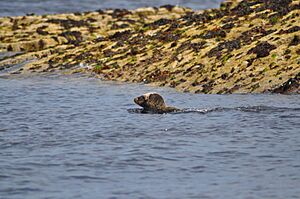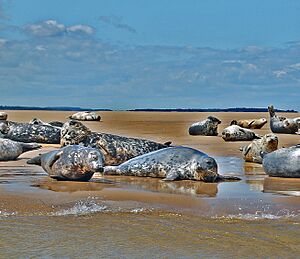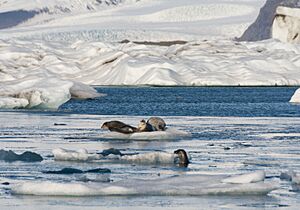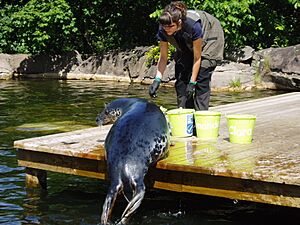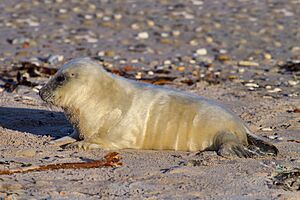Grey seal facts for kids
Quick facts for kids Grey seal |
|
|---|---|
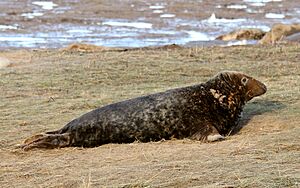 |
|
| Male | |
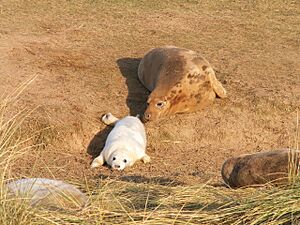 |
|
| Female with pup | |
| Conservation status | |
| Scientific classification | |
| Genus: |
Halichoerus
|
| Species: |
grypus
|
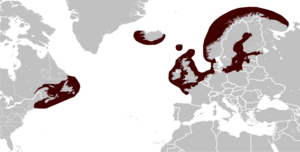 |
|
| Grey seal range | |
The grey seal (Halichoerus grypus) is a big type of seal. It belongs to a group called Phocidae, which are also known as "true seals" or "earless seals" because they don't have outside ear flaps. The grey seal is the only species in its genus called Halichoerus. You can find these seals on both sides of the North Atlantic Ocean. In Latin, Halichoerus grypus means "hook-nosed sea pig." In the US, it's spelled gray seal. People also call it the Atlantic seal or the horsehead seal.
Contents
Grey Seal Subspecies
There are two main types, or subspecies, of the grey seal:
| Image | Subspecies | Where They Live |
|---|---|---|
 |
Halichoerus grypus grypus Fabricius, 1791 | Baltic Sea |
 |
Halichoerus grypus atlantica Nehring, 1886 | Western North Atlantic (eastern Canada and northeastern United States), and Eastern North Atlantic (British Isles, Iceland, Norway, Denmark, Faroe Islands, and Russia) |
Scientists found that the grey seals in the eastern and western Atlantic have been different for at least one million years. This means they might even be considered completely separate subspecies.
What Grey Seals Look Like
Grey seals are quite large. Male seals in the eastern Atlantic can be about 1.95 to 2.3 meters (6.4 to 7.5 feet) long. They weigh between 170 and 310 kilograms (370 to 680 pounds). Female seals are smaller, usually 1.6 to 1.95 meters (5.2 to 6.4 feet) long. They weigh 100 to 190 kilograms (220 to 420 pounds).
Seals in the western Atlantic are often much bigger. Males can average up to 2.7 meters (8.9 feet) and weigh as much as 400 kilograms (880 pounds). Females can average up to 2.05 meters (6.7 feet) and sometimes weigh up to 250 kilograms (550 pounds). The largest male grey seals ever recorded were about 3.3 meters (10.8 feet) long.
You can tell a grey seal from a smaller harbor seal by its straight head and wide-set nostrils. Grey seals also have fewer spots on their bodies. They don't have outside ear flaps and have large snouts. Males usually have bigger noses than females. Male grey seals are also darker than females, with lighter patches and scars around their necks. Females are silver-grey to brown with dark patches.
Where Grey Seals Live
In the United Kingdom and Ireland, grey seals have many breeding groups along the coasts. Some very large groups are found at Blakeney Point in Norfolk and Donna Nook in Lincolnshire. There are also big groups at the Farne Islands (about 6,000 seals) and Orkney in Scotland. Other places include Lambay Island in the Irish Sea and Ramsey Island in Wales. In Germany, you can find them near the islands of Sylt, Amrum, and Heligoland.
In the western North Atlantic, many grey seals live in the coastal waters of Canada's Maritime Provinces. They are also found south to Nantucket in the United States. In Canada, they are often seen in places like the Gulf of St. Lawrence and Newfoundland. The biggest group of grey seals in the world is on Sable Island, Nova Scotia. In the United States, they live all year off the coast of New England, especially Maine and Massachusetts. They have also been seen in Connecticut, New York, and Rhode Island.
There is also a separate group of grey seals living in the Baltic Sea.
During winter, grey seals often rest on rocks, islands, and sandbars near the shore. Sometimes, they come onto beaches to rest. In spring, young seals that have just stopped drinking their mother's milk sometimes get separated from their group and end up on beaches.
Grey Seal Predators
Grey seals can be hunted by other animals. Their main predator is the orca, also known as the killer whale. Some large sharks also hunt grey seals in North America. These include great white sharks, bull sharks, and Greenland sharks. Sometimes, dead grey seals are found with special "cookie cutter" bite marks. This is a sign that a Greenland shark attacked them. In the waters around Great Britain, killer whales often hunt grey seals. Young grey seal pups are sometimes taken from beaches by large birds like white-tailed eagles and golden eagles.
What Grey Seals Eat
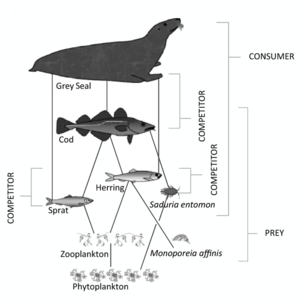
Grey seals eat many different kinds of fish. They mostly eat fish that live near the bottom of the ocean, at depths of 70 meters (230 feet) or more. Small fish called sand eels are a very important part of their diet in many areas. They also eat cod, flatfish, herring, and skates. Grey seals will eat whatever food is available, including octopus and lobsters.
A grey seal needs to eat about 5 kilograms (11 pounds) of food each day. However, they don't eat every day. They also stop eating completely during the breeding season.
Scientists have seen grey seals hunting and eating other large animals. This includes harbour seals and harbour porpoises. In 2014, a male grey seal was filmed killing 11 young seals of its own kind in one week. This behavior might help male seals get more food easily without leaving their best territories.
How Grey Seals Communicate
For a long time, people thought marine mammals only used sounds to talk to each other. But new research shows that grey seals also clap their flippers underwater! They do this to scare away predators. During mating season, they might clap to find a partner.
Scientists were surprised by how loud these seals could clap underwater. This behavior makes sense because it helps them protect themselves and find mates. While seals are known for clapping in zoos, this was the first time it was seen in the wild.
Grey Seal Life Cycle and Reproduction

Grey seals are "capital breeders." This means they eat a lot to build up fat in their bodies. They use this stored fat when they are breeding and feeding their pups. They don't hunt for food during this time.
Female seals give birth to one pup every year. They can start having pups as early as 4 years old and continue until they are about 30. Only the mother takes care of the pup. During breeding, male seals don't help with the pups. Instead, they protect the females from other males so they can mate.
Pups are born weighing about 14 kilograms (31 pounds). In the eastern Atlantic, they are born in autumn (September to December). In the west, they are born in winter (January to February). Pups are born with soft, white fur. They grow very quickly by drinking their mother's milk, which is extremely rich in fat (up to 60% fat!).
Young pups are quite developed at birth. After a few weeks, the mother seal goes back to the sea to find food. The pups also go through a period where they don't eat after they stop drinking milk. Then, they leave the land and learn to swim and fish for themselves. Within about a month, they lose their white pup fur and grow thick, waterproof adult fur.
The number of grey seals has been increasing in the west, especially in the U.S. and Canada. Because of this, some people have suggested hunting seals to control their numbers.
About 80-85% of seal pups survive their first year in some places. In other places, less than 50% survive. Pups often die because they have trouble learning to find food on their own.
Grey Seal Status and Protection
In the United States, grey seals were almost wiped out because people hunted them for their oil, meat, and skins. Bounties (rewards for killing them) were paid until 1945 in Maine and 1962 in Massachusetts. After the Marine Mammal Protection Act of 1972 was passed in 1972, it became illegal to harm or bother seals. A survey in 1973 found only 30 grey seals along the entire coast of Maine.
At first, the grey seal population grew slowly, but then it bounced back. They started breeding again on islands off Maine and near Cape Cod. The southernmost breeding group started on Muskeget Island in 1988 with five pups. By 2008, over 2,000 pups were counted there. A study showed that the grey seals in the United States came from Canadian seals moving south.
By 2009, thousands of grey seals were living near popular swimming beaches on Cape Cod. This led to more sightings of great white sharks coming close to shore to hunt the seals. In 2011, a count found 15,756 grey seals in the waters of southeastern Massachusetts. Grey seals are now being seen more often in New York and New Jersey. Scientists expect them to start new breeding groups even further south.
Human-made noise pollution can affect how marine animals communicate. This is a growing concern for protecting ocean life. The discovery that seals use clapping to communicate highlights how important it is to study the effects of human noise.
In the UK, seals are protected by the Conservation of Seals Act 1970. However, this law does not apply to Northern Ireland. Some fishermen in the UK have also asked for seals to be hunted. They claim that fish numbers have gone down because of the seals.
The grey seal population in the Baltic Sea grew by about 8% each year between 1990 and the mid-2000s. Since 2005, the numbers have stayed about the same. As of 2011, hunting grey seals is allowed in Sweden and Finland. Another cause of death for seals is getting caught and drowning in fishing nets.
Grey Seals in Zoos
Grey seals do well living in zoos and aquariums. You can often find them in zoos, especially in Europe. In the past, they were popular circus animals. They were often used in shows where they would balance things or perform tricks.



